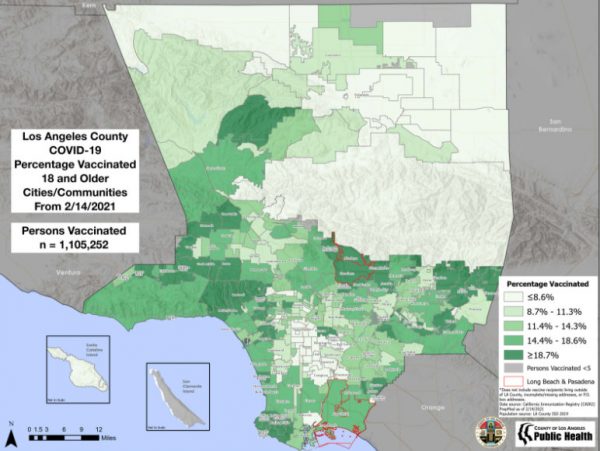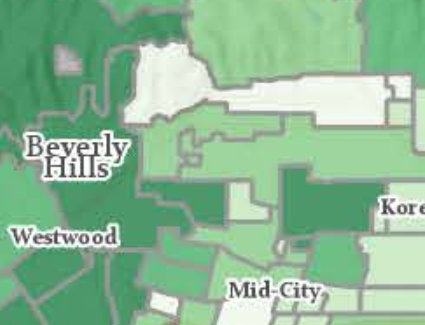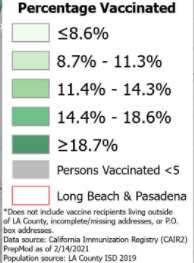
Approximately 11% to 14% of West Hollywood’s residents have gotten the COVID-19 vaccine so far, according to figures released by Los Angeles County health officials on Friday. Meanwhile, 15.5% of LA County residents have gotten at least one dose of the vaccine.
Consulting a new countywide map highlighting vaccination rates in individual communities shows somewhere between 11.4% and 14.3% of WeHo residents 18 and older have gotten at least one dose of the vaccine.
Meanwhile in the areas surrounding West Hollywood, the vaccination rates among those 18 and older vary greatly according to the map:
- Beverly Hills – greater than 18.7%
- Carthay neighborhood – greater than 18.7%
- Culver City – greater than 18.7%
- Hollywood – less than 8.6%
- Melrose neighborhood – 11.4% to 14.3%
- Miracle Mile – 11.4% to 14.3%
- Park La Brea – 8.7% to 11.3%
- Santa Monica – 14.4% to 18.6%
Below is a clip from the larger county map focusing on the West Hollywood area. The larger county map does not have zoom-in capability, so the map focusing on WeHo is slightly blurry since WEHOville had to enlarge it to get the clip.


More than 1.6 million doses of COVID-19 vaccines have been administered in Los Angeles County since December.
Some 15.5% of the county’s population aged 18 and over have received at least one dose of the vaccine, while 6% are fully vaccinated.
According to figures provided by Dr. Paul Simon, the county health department’s chief science officer, LA County has administered a total of 1,205,738 first doses of the vaccine, along with 471,162 second doses.
Los Angeles County has a population of approximately 10 million people.
However, still greatly concerning to county health officials is equity in distribution of the shots. Simon reported vaccination rates among eligible black residents lagging far behind other ethnic groups.
According to figures released by the county Department of Public Health, the ethnic breakdown of those who have received at least one dose of COVID-19 vaccine as of mid-February is:
- 33.5% White
- 23.1% Latino
- 19.1% Asian
- 5.2% Black
Among those 65 and older who have received at least one dose of the vaccine, 42.8% have been white, while only 24% have been black.
“There are marked inequities in vaccination coverage across the county, with the lowest coverage rates in South L.A., East L.A., several regions of the San Gabriel Valley, the east San Fernando Valley and the Antelope Valley, as well as several pockets near the ports and below West Hollywood,” Simon said.
He acknowledged that the coverage rates were calculated based on each area’s overall population, not the number of people actually eligible to receive the shots. But he said despite that limitation, “the findings are deeply concerning and provide further illustration of the deeply rooted health inequities that exist in our society.”
Simon said the county is planning a number of steps to address the inequities, such as prioritizing the establishment of more vaccination sites in areas with the lowest rates, expanding mobile vaccination services to serve older residents and people with limited ability to travel to vaccine sites.
The county is also reserving doses so they can be administered in under-served communities, with 6,000 to 7,000 doses expected to be reserved next week for South Los Angeles and 1,000 to 2,000 in the Antelope Valley, he said.
“These inequities are unjust and unacceptable and demand renewed efforts to address them,” Simon said.
The county also plans to reserve appointment slots at its various vaccination sites for residents of under-served communities, and it will be increasing efforts to help residents schedule appointments.
However, many people attempting to reserve vaccination appointments report it is a frustrating experience. People must fill out large amounts of information on the website before being allowed to reserve an appointment time, only to find that appointment has been taken by someone else before they finish filling out the forms online.
Efforts have previously been made to ensure easy access to vaccinations for residents of traditionally underserved areas, notably through the placement of mass-vaccination sites in locations such as the Forum in Inglewood, the county Office of Education in Downey and the Pomona Fairplex.
But Simon noted that while he had no specific numbers, it was clear that sites like the Forum — despite being targeted for residents of that area – – were administering shots to people from more affluent neighborhoods who traveled to the location.
“I don’t have to look at the numbers to be aware. I’ve worked at several of the Mega PODs (points of distribution) and it really was quite striking,” Simon said. “… It’s an observation that many have made that many people receiving vaccinations at these large Mega PODs were not from the neighborhood.”
He said it is difficult to immediately address the issue, but predicted when the state’s “My Turn” appointment system becomes the universal standard for reserving a vaccination slot, it may be possible to ensure times are being reserved solely for local or underserved communities.
Simon said the county is also trying to increase its work with community leaders to help counter what he called continuing misinformation about the safety of the vaccines that is likely contributing to low vaccination rates.
Simon said there are still issues with vaccine supply, although the county’s sites were largely spared from the weather-related delivery problems that forced the Los Angeles city-run vaccination sites like Dodger Stadium to close this week.
Come March 1, the already jammed appointment system is expected to get more crowded as essential workers such as teachers, food service workers and law enforcement will become eligible for shots.
In mid-March, everyone aged 16 and over with a serious underlying health condition will become eligible.
Gov. Gavin Newsom on Friday said in March, the state will begin reserving 10% of the overall supply of vaccines to be administered to teachers, as part of an effort to speed a return to in-person classes.
Simon said he did not envision that restriction causing major issues in the county, since health officials planned to allocate “a significant percentage” to teachers and the other categories of essential workers.
City New Service contributed information for this story.
